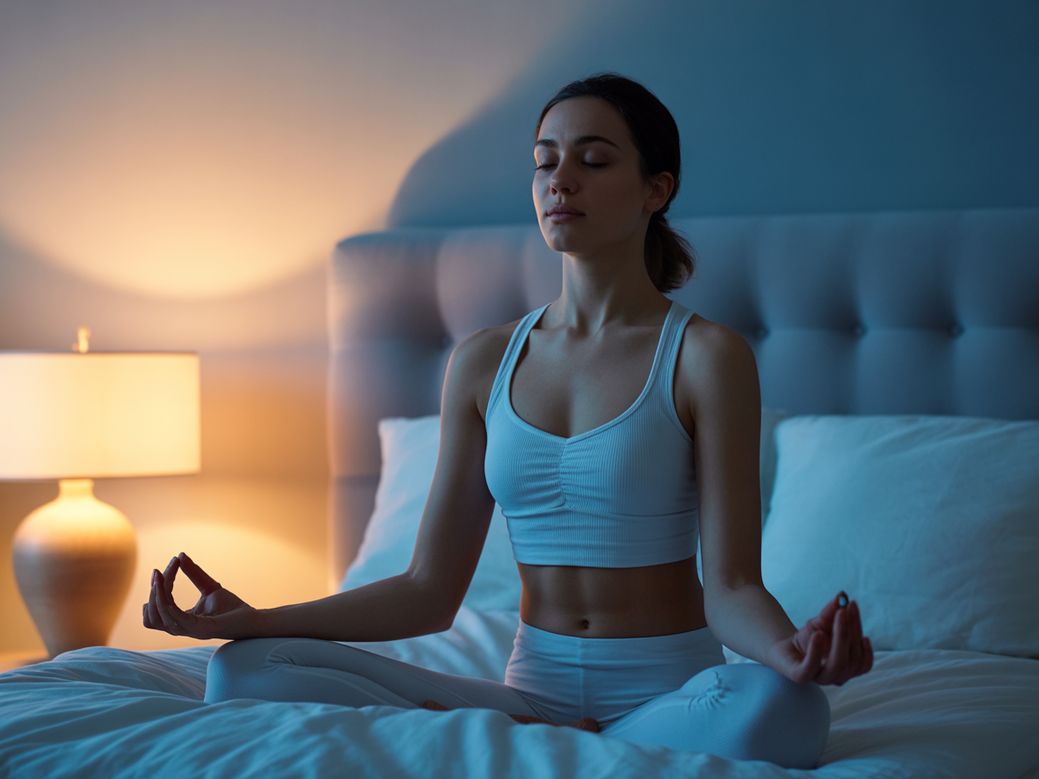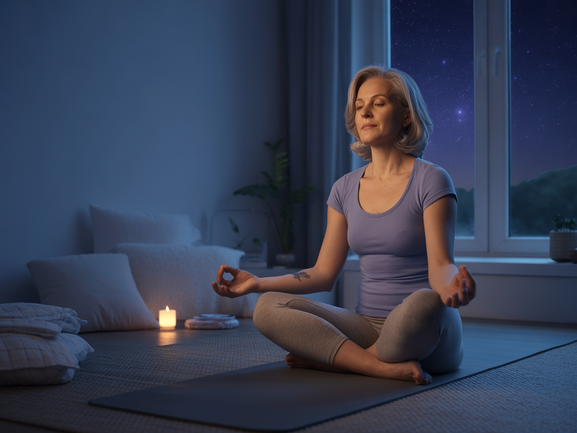How Can Yoga for Sleep Transform Your Nights?
The Modern Epidemic of Sleeplessness
If you find yourself tossing and turning at night, you are far from alone. Millions of people struggle with sleep-related issues, turning peaceful nights into a source of anxiety. In our fast-paced world, the ability to disconnect and achieve deep, restorative rest has become a significant challenge. But what if the solution wasn’t in a pill, but in a practice thousands of years old? Yoga for sleep offers a natural, powerful, and accessible path to reclaiming your nights.
This practice combines gentle physical postures (asanas), controlled breathing (pranayama), and mindfulness meditation to calm the central nervous system, release physical tension, and prepare the mind for profound rest. It’s not about complex poses or intense workouts; it’s a gentle invitation for your body and mind to unwind.
Meet Luzia, a world-renowned yoga instructor and the visionary co-founder of the Vitalizen App | Yoga + Meditation. With decades of experience teaching across the globe, Luzia has dedicated her life to making these transformative practices available to everyone. Her mission is to provide a digital sanctuary where anyone, anywhere, can find tranquility and master the art of sleeping well.

The Science of Serenity: How Yoga Improves Sleep Quality
How can simple stretching and breathing exercises so dramatically improve sleep? The magic lies in yoga’s profound effect on your body’s stress-response system. Practices like restorative yoga for sleep and guided sleep meditation are scientifically validated methods for reducing stress and anxiety—the primary culprits behind insomnia.
When you engage in a bedtime yoga routine, you activate your parasympathetic nervous system, also known as the “rest and digest” system. This activation triggers a cascade of physiological changes:
- Reduction in Cortisol: It lowers the levels of cortisol, the primary stress hormone, which often keeps you alert and awake.
- Increased GABA Levels: Studies suggest that yoga can increase levels of Gamma-aminobutyric acid (GABA), a neurotransmitter that helps calm nerve activity. Low GABA levels are linked to anxiety and sleep disorders.
- Heart Rate and Blood Pressure Regulation: The practice helps lower your resting heart rate and blood pressure, guiding your body into a state of deep relaxation essential for falling asleep.
According to a study published by the National Institutes of Health (NIH), consistent yoga practice significantly improves sleep efficiency, reduces sleep disturbances, and decreases the need for sleep aids among individuals with chronic insomnia.
Why Prioritizing Quality Sleep is Non-Negotiable
Quality sleep is not a luxury; it is a fundamental pillar of physical, mental, and emotional health. Consistently achieving 7-9 hours of restorative rest empowers your body and mind to function at their peak. Think of it as the foundation upon which your daily performance, mood, and long-term health are built.
The benefits of prioritizing your sleep are extensive and transformative:
- Enhanced Cognitive Function: Deep sleep is when your brain consolidates memories and clears out metabolic waste. Quality rest leads to improved focus, sharper problem-solving skills, and enhanced creativity.
- Strengthened Immune System: During sleep, your body produces cytokines, proteins that target infection and inflammation. Chronic sleep loss can weaken your immune defenses, making you more susceptible to illness.
- Improved Mood and Emotional Regulation: Sleep deprivation is strongly linked to irritability, stress, and a higher risk of mood disorders. A well-rested mind is more resilient, positive, and emotionally balanced.
- Better Physical Health: Consistent, quality sleep helps regulate metabolism and reduces the risk for chronic conditions such as heart disease, diabetes, and obesity.
Your Step-by-Step Guide to Starting a Bedtime Yoga Practice Tonight
Embarking on your journey to better sleep through yoga is simpler than you might imagine. You don’t need prior experience or fancy equipment. With expert guidance from instructors like Luzia on the Vitalizen App, you can begin tonight. Here’s how to create your new favorite ritual:
- Create a Tranquil Atmosphere: About 30 minutes before bed, dim the lights, put away electronic devices, and ensure your bedroom is quiet. Your environment is a powerful signal to your brain that it’s time to wind down.
- Choose a Gentle, Guided Routine: Start with a short, 10-15 minute guided session. The Vitalizen app offers a library of routines specifically designed for beginners and for promoting sleep, focusing on gentle yoga for sleep.
- Listen to Your Body: The goal is relaxation, not exertion. Move slowly and mindfully, never forcing a pose. If something doesn’t feel right, gently back off. The focus should always be on your breath and the sensations in your body.
- Focus on Your Breath: Breathing is the anchor of yoga for sleep. Inhale deeply through your nose, and exhale slowly. This simple act is incredibly effective at calming the nervous system.
- Be Consistent: The true benefits of a bedtime yoga routine come from consistency. Make it a non-negotiable part of your nightly schedule, just like brushing your teeth.
🎯 Ready to start? Download the Vitalizen App and try your first guided sleep session tonight!
The Best Restorative Yoga Poses for Insomnia
Certain yoga postures are exceptionally effective at preparing the body for deep sleep. These restorative poses help release the physical and mental tension that accumulates throughout the day. Luzia recommends focusing on poses that are grounding, calming, and can even be done in your bed.
The table below highlights some of the most effective poses you can find in the Vitalizen app’s guided bedtime yoga routines. These are central to any effective yoga for sleep practice.
| Pose Name | Common Name | Primary Benefit for Sleep |
|---|---|---|
| Balasana | Child’s Pose | Gently stretches the back, calms the brain, and relieves stress. |
| Viparita Karani | Legs-Up-The-Wall Pose | Alleviates tired legs, calms the nervous system, and promotes deep relaxation. |
| Supta Baddha Konasana | Reclining Bound Angle Pose | Opens the hips to release stored tension and calm the nervous system. |
| Savasana | Corpse Pose | The ultimate relaxation pose; allows the body to fully integrate the practice and enter a state of complete rest. |
| Marjaryasana-Bitilasana | Cat-Cow Stretch | Synchronizes breath with movement, releasing tension in the spine and calming the mind. |
Your Pocket Sanctuary: The Vitalizen App for Better Sleep
We know that life is demanding. Finding the energy for a yoga class when you’re already exhausted can feel like an insurmountable task. That’s precisely why we created the Vitalizen App. It’s designed to be your personal yoga and meditation guide, available 24/7 in your pocket, ready to lead you to restful sleep whenever you need it.
Our app provides a rich library of guided sessions, from a quick 5-minute mindfulness for insomnia practice to a comprehensive 30-minute restorative yoga for sleep routine. With Luzia’s expert, soothing guidance, you can transform your bedroom into a personal wellness retreat.
💡 Tip: Explore our “Sleep Stories” section in the app—guided narratives combined with gentle sounds to help you drift off effortlessly.
Frequently Asked Questions About Yoga for Sleep
How long does it take for yoga to improve my sleep?
While many people feel a sense of calm and relaxation after just one session, the most significant benefits for sleep quality come from consistency. We recommend practicing for at least 10-15 minutes every night. Most Vitalizen app users report noticeable improvements in their ability to fall asleep and stay asleep within the first two weeks of consistent practice. The key is creating a sustainable bedtime yoga routine.
What are the best yoga poses for insomnia?
The best poses are gentle, restorative, and calming. Focus on postures like Child’s Pose (Balasana), Legs-Up-The-Wall Pose (Viparita Karani), Reclining Bound Angle Pose (Supta Baddha Konasana), and the ultimate relaxation pose, Corpse Pose (Savasana). The Vitalizen app features a dedicated “Bedtime Yoga” collection with guided routines that incorporate these and other highly effective poses for insomnia relief.
Is it safe to do yoga right before bed?
Absolutely. A gentle and calming yoga for sleep routine is one of the best times to practice. It helps you consciously release the physical and mental tensions of the day, signaling to your body that it’s safe to rest. Just be sure to avoid vigorous or energizing styles of yoga (like Power Yoga or Ashtanga) close to bedtime.
I’m a complete beginner. Can I still use the Vitalizen app for sleep?
Of course! The Vitalizen app is designed for all experience levels, especially absolute beginners. Our guided sleep meditation and yoga sessions provide clear, easy-to-follow instructions to ensure you have a safe, enjoyable, and effective experience from your very first session. Start your journey with us today!
Do I need any special equipment to start a bedtime yoga routine?
No special equipment is necessary. All you need is a comfortable, quiet space. While a yoga mat can be nice, you can easily practice on a carpeted floor. For many of the gentle yoga for sleep routines, you can even do the poses right in your bed. The most important tool is your breath and your intention to relax.

